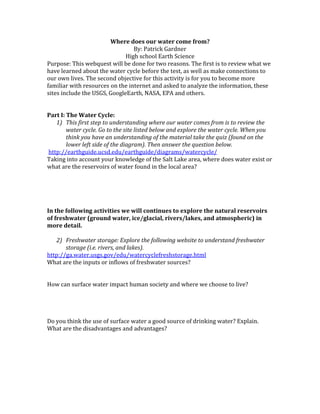
Webquest
- 1. Where does our water come from? By: Patrick Gardner High school Earth Science Purpose: This webquest will be done for two reasons. The first is to review what we have learned about the water cycle before the test, as well as make connections to our own lives. The second objective for this activity is for you to become more familiar with resources on the internet and asked to analyze the information, these sites include the USGS, GoogleEarth, NASA, EPA and others. Part I: The Water Cycle: 1) This first step to understanding where our water comes from is to review the water cycle. Go to the site listed below and explore the water cycle. When you think you have an understanding of the material take the quiz (found on the lower left side of the diagram). Then answer the question below. http://earthguide.ucsd.edu/earthguide/diagrams/watercycle/ Taking into account your knowledge of the Salt Lake area, where does water exist or what are the reservoirs of water found in the local area? In the following activities we will continues to explore the natural reservoirs of freshwater (ground water, ice/glacial, rivers/lakes, and atmospheric) in more detail. 2) Freshwater storage: Explore the following website to understand freshwater storage (i.e. rivers, and lakes). http://ga.water.usgs.gov/edu/watercyclefreshstorage.html What are the inputs or inflows of freshwater sources? How can surface water impact human society and where we choose to live? Do you think the use of surface water a good source of drinking water? Explain. What are the disadvantages and advantages?
- 2. 3) In this activity we will explore ground water. Go to the following webpage and take a look around. Pay particular attention to the diagrams. Then answer the following questions. http://pubs.usgs.gov/of/1993/ofr93-643/ What is an aquifer? What conditions need to be present in order for rocks make a good aquifer? What types of rocks are these? Do you think the use of ground water a good source of drinking water? Explain. What are the disadvantages and advantages? 4) Now explore the following webpage to learn about glaciers: http://ga.water.usgs.gov/edu/earthglacier.html What are the major types of glaciers? Explain the effect glaciers can have on the landscape? Do you think the use of glacial water a good source of drinking water? Explain. What are the disadvantages and advantages? 5) The next webpage provides information about water found in the atmosphere. http://ga.water.usgs.gov/edu/watercycleatmosphere.html What is the percentage of freshwater found in the atmosphere?
- 3. How does water move from the surface of the earth to the atmosphere. And how is this water then transferred back to the surface? Do you think the use of atmospheric water a good source of drinking water? Explain. What are the disadvantages and advantages? 6) To summarize what we have learned about the water cycle, I would like you to carefully read the following article. Finally, write a healthy paragraph (4-6 sentences) relating the water cycle to your life. http://earthobservatory.nasa.gov/Features/Water/ Part II: Drinking Water 7) The following website gives information about the sources of drinking water. http://cec.vcn.bc.ca/cmp/modules/wat-sou.htm What are the three major sources of water? How do these relate to the water cycle?
- 4. How is the water captured in each one of these sources? In the next section we are going to learn where the water in salt lake comes from. Before we do that take a guess. Where do you think your drinking water comes from? Briefly explain. 8) 8) In the next section I want you to find Salt Lake City in GoogleEarth. Once there ensure that you are viewing the aerial photographs. Use the scale tool to zoom in and out. While doing this note the reservoirs of water found in the local area (i.e. rivers and lakes). If you do not have GoogleEarth on your computer you can use earth view in google maps. https://maps.google.com/maps?ftr=earth.promo&hl=en List the seven creeks that enter salt lake city? 9) In this next activity we are going to determine where your drinking water comes from. Open the following link. Under the “Water Program Snapshots” tab on the right side of the screen click drinking water information. Then look at the surface water reservoirs. Type in your address in the upper left corner. http://watersgeo.epa.gov/mwm/ Find the water shed that is closes to your home and click on it. What is the name of this water shed? How many people does this source serve? What do you think our responsibility is in protecting our local water sources?
- 5. 10) Finally, explore the following webpage concerning different issues surrounding access to water. http://www.nrdc.org/water/ What is something an individual can do to protect our water sources? What can be done on a societal level to better protect our water sources?